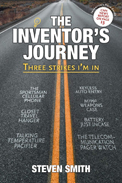
 |
In his innovative book, Smith offers readers practical and useful advice for succeeding in the world of inventing. Whether trying to make a career out of invention or simply bring a product to market that will help people and simplify their lives, walking the path of the inventor is something that defies a lot of conventions and can make a person’s most cherished ideas vulnerable. Though there are plenty of companies and individuals who claim to be able to help and keep their client’s best interests at heart, not all of them are scrupulous and worthy of being trusted. But as a solo entrepreneur, how is it possible to figure out who is looking to help and who just wants to scam a quick buck? Though the signs can be hard to see at first, especially when there is a genuine excitement to create something for the masses, concrete examples and suspicious emails are provided in Smith's book to give readers an unambiguous playbook of what to watch out for. In this helpful guide, the author shares his personal experiences getting inventions to market, using his own missteps and less-than-ideal outcomes as examples of what to look for and what to avoid, helping to create more of a community watch for fellow inventors and keep the bad actors from sinking anyone else’s dreams.
Once a partnership is formed with a company and money can start being made, the author pivots to the successful side of inventing, highlighting the various types of contracts that can be signed, the legal forms that inventors will want to make sure they have familiarity with, and how a single invention can be refined and made into a long-term profit maker. From filing patents to negotiating exclusivity rights, this book will offer readers a step-by-step process they can follow, meaning that all they have to do is come up with the idea for an invention. For any kind of non-traditional employment where a person is on their own and has to figure things out as one goes, it can be all too easy to get started without fully realizing the long-term ramifications of decisions being made on a daily basis. Inventors must deal with this on a much larger scale, needing to protect proprietary ideas and designs from being retooled or beating them to market while at the same time needing to divulge those elements to strangers who might profess to be on their side. This makes it all the more valuable for this advice to be coming not only from someone who has lived it but is also not trying to make money off the people who can benefit from these lessons.
The use of design documents, scanned and redacted contracts, legal forms, and other real-world items that will be familiar to inventors at any step of the process helps take these concepts and root them firmly in reality. The author’s style is very direct and relatable, speaking to concerns and questions that anyone in this position would naturally come to on their own but then guiding them through in an authoritative yet approachable way. Even sharing moments of vulnerability and false hope goes a long way to reaching readers of this book directly in the moment they may be experiencing. Inventors keep the world moving forward with new technologies and fresh ideas, and the author’s way of supporting them with no-nonsense direction to navigate the business side of things only stands to benefit everyone, including consumers. Smith’s short and sweet list of dos and don’ts should be the first thing a prospective inventor should reach for after completing a sketch, design, or blueprint.